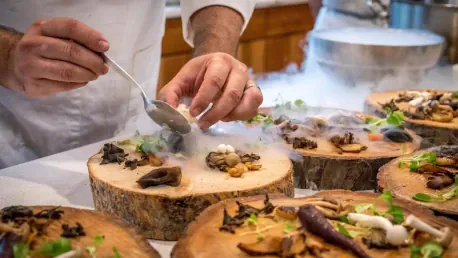The culinary world is ever-evolving, driven by changing consumer preferences, technological advancements, and a growing emphasis on sustainability and health. As we look ahead to 2025, several key trends are poised to redefine the food and beverage industry. These trends reflect a dynamic landscape where innovation and tradition intersect, offering exciting opportunities for both consumers and industry stakeholders. With an emphasis on diverse flavors, sustainable practices, and cutting-edge technology, the upcoming trends paint a vivid picture of a vibrant future for the culinary world.
Ethnic Fusion
Ethnic fusion cuisine, which blends traditional ethnic dishes from various parts of the world, is gaining popularity among adventurous eaters who seek diverse and integrated culinary experiences. This trend is driven by a desire for novel flavors and ingredients and a growing appreciation for cultural mashups. According to Datassential, 58% of consumers are interested in fusion cuisine, indicating a significant shift towards global culinary experimentation, making it a vital trend for chefs and restaurants to consider.
Restaurants and chefs are increasingly incorporating elements from various cultures into their menus, creating unique and flavorful dishes that captivate diners. This trend not only broadens the culinary landscape but also fosters cultural appreciation and understanding through food. By blending the best of various culinary traditions, chefs can craft innovative dishes that appeal to a wide range of tastes and preferences. The surge in ethnic fusion cuisine can enhance dining experiences, making it more exciting for consumers and encouraging them to explore new and diverse flavors.
Plant-Based Evolution
The plant-based movement continues to grow, evolving to meet the needs of an increasingly diverse consumer base. Innovations in plant-based meats, dairy, and seafood are making these alternatives more appealing and accessible to a broader audience. The Good Food Institute projects the plant-based food market to reach $74.2 billion by 2027, driven by an annual growth rate of 11.9%. These products are becoming more similar in taste and texture to their animal-based counterparts, which attracts a wider consumer base committed to health, environmental, and ethical reasons.
As more people adopt plant-based diets, the market for these products is expected to expand further, reflecting the industry’s commitment to providing sustainable and nutritious alternatives to traditional animal-based foods. Plant-based solutions not only appeal to vegetarians and vegans but increasingly to flexitarians who seek to incorporate more plant-based elements into their diets. This trend highlights the industry’s responsiveness to consumer preferences and showcases a commitment to a more sustainable and health-conscious future in food production.
Lab-Grown Foods
Lab-grown, or cultivated, foods are gaining traction as sustainable and ethical alternatives to conventional animal farming. These foods, produced from cells in controlled environments, offer a way to create meat, dairy, and seafood without the environmental and ethical issues associated with traditional farming methods. By 2025, the cultivated meat market is expected to grow at a CAGR of 41.4%, potentially reaching $5.1 billion, according to Market Data Forecast. This trend represents a significant shift towards sustainable consumption and reducing environmental impact.
Cultivated foods offer solutions to numerous challenges faced by traditional farming, such as resource depletion, animal welfare concerns, and the large carbon footprint associated with livestock production. As technology advances and production techniques become more efficient, these products are becoming more viable and accepted by consumers. This nod towards sustainable food practices reflects a broader commitment to innovation and ethical consumption, paving the way for a greener future in the food industry. Lab-grown foods could indeed be a key player in addressing the growing global food demand sustainably.
Functional Foods
Functional foods, which offer health benefits beyond basic nutrition, are becoming increasingly important in consumers’ diets. These foods are often fortified with probiotics, prebiotics, adaptogens, and superfoods, catering to health-conscious individuals who seek to support their overall well-being. Grand View Research projects the global functional food market to grow from $177.77 billion in 2020 at a CAGR of 8.6% from 2021 to 2028, reflecting robust consumer interest in health-enhancing foods.
Consumers are increasingly seeking foods that promote gut health, boost immunity, and enhance mental clarity, leading to a rise in products designed to address these specific health needs. This trend underscores the growing importance of nutrition in maintaining a healthy lifestyle and the consumer’s desire for targeted dietary solutions. Food companies are responding by creating innovative products that provide both essential nutrients and added health benefits, marking a significant shift towards health-oriented eating habits and showcasing an industry dedicated to enhancing consumer wellness through diet.
Zero-Waste Cooking
Zero-waste cooking is gaining traction as part of broader sustainability efforts aimed at reducing food waste and promoting environmental responsibility. Chefs and home cooks alike are finding innovative ways to use all parts of ingredients, minimizing waste, and making full use of available resources. The World Wildlife Fund highlights that 1.3 billion tons of food are wasted annually, emphasizing the necessity for more sustainable practices in food preparation and consumption.
By embracing zero-waste cooking practices, the food industry can significantly reduce its environmental footprint and operational costs. This trend also encourages creativity in the kitchen, leading to the development of new and exciting culinary creations from what would otherwise be discarded. By adopting a zero-waste mindset, consumers and businesses can contribute to a more sustainable food system, helping to conserve resources and reduce the overall impact on the planet. This approach underscores the vital role of sustainability in contemporary culinary practices, promoting responsible consumption and innovation in food preparation.
Upcycled Ingredients
Upcycling food by-products into new, value-added products is becoming an essential trend in the food industry. The Upcycled Food Association reports a market valuation of $46.7 billion for upcycled foods, with a 5% annual growth rate, highlighting the significant interest in this sustainable practice. This trend appeals to environmentally-conscious consumers who prioritize sustainability, reducing food waste, and supporting eco-friendly products.
Upcycled ingredients not only help reduce food waste but also create new revenue streams for producers by turning by-products into nutritious and innovative food items. This approach aligns with the growing demand for sustainable and eco-friendly products, emphasizing the industry’s adaptability and commitment to sustainability. By repurposing what would otherwise be wasted, companies can contribute to a circular economy, ensuring that resources are utilized more efficiently. The trend towards upcycled ingredients reflects a broader movement towards sustainability and showcases the potential for innovation in food production.
Regenerative Agriculture
Regenerative agriculture, which focuses on restoring and enhancing soil health, biodiversity, and ecosystems, is gaining prominence as a solution to combating climate change. According to the Rodale Institute, regenerative farming can sequester 100% of annual CO2 emissions, making it a critical practice for environmental sustainability. This holistic approach to agriculture emphasizes the importance of soil health and the need to create farming systems that are both productive and sustainable.
Products marketed as “regeneratively farmed” are expected to become more prevalent as consumers increasingly seek out foods that support environmental sustainability. This trend highlights the critical role of sustainable farming practices in ensuring a healthy and resilient food system. By adopting regenerative agriculture techniques, farmers can improve soil fertility, increase biodiversity, and contribute to the fight against climate change. This trend reflects a broader understanding of the interconnectedness of agriculture and the environment, emphasizing the need for responsible and sustainable farming practices in the food industry.
Alternative Flours & Grains
Interest in alternative flours and grains, such as teff, amaranth, and cassava, is growing due to their unique textures, flavors, and sustainability benefits. Grand View Research estimates the alternative flours market to grow at a CAGR of 7.2% from 2021 to 2028, reaching $35.24 billion. These diverse ingredients offer new possibilities for culinary innovation, allowing chefs and home cooks to experiment with novel recipes that cater to contemporary dietary preferences.
Alternative flours and grains support biodiversity and provide nutritious options that can enhance the variety in consumers’ diets. This trend reflects a broader movement towards more sustainable and varied food choices that prioritize both health and environmental considerations. By incorporating these ingredients into their offerings, food producers and chefs can meet the growing demand for diverse and nutritious products while promoting sustainable agricultural practices. This trend signifies a shift towards a more holistic and eco-conscious approach to food production and consumption, highlighting the importance of diversity in diets.
Immunity-Boosting Foods
The culinary landscape is continuously transforming, fueled by evolving consumer tastes, technological progress, and an increasing focus on sustainability and wellness. As we anticipate the trends leading up to 2025, several key developments are destined to reshape the food and beverage sector. These emerging trends illustrate a dynamic environment where innovation merges with tradition, providing thrilling possibilities for both consumers and industry participants.
The future holds a focus on diverse, global flavors that will tantalize taste buds while sustainable practices will become paramount, ensuring food production is environmentally friendly. Cutting-edge technology will play a pivotal role, enhancing food quality, safety, and delivery processes. Combined, these trends indicate a vibrant and exciting future for the culinary world, promising an array of novel dining experiences and healthier, more sustainable eating habits. The industry is set to embrace changes that not only appeal to the palate but also align with a growing consciousness about health and the planet.









